PC Power & Cooling Silencer 750 Quad CF-Edition
by Christoph Katzer on July 18, 2007 1:00 AM EST- Posted in
- Cases/Cooling/PSUs
Temperatures (Ambient 25-50°C)
We feel it is important to show what each power supply is truly capable of providing. The easiest way to separate the cream of the crop from inferior quality is to let the power supplies run in a very hot environment. Cheap components give up quickly and under stress conditions we can force lesser power supplies to fail. Good components will withstand the tremendous heat and keep on running. With increasing heat we will see the voltage of each rail dropping. This is a normal response from the components since they cannot deliver the same performance with increasing temperatures.
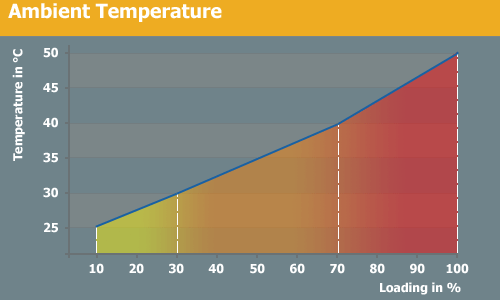
To heat up a box to 50°C you don't necessarily need a thermal chamber. For our tests we are using a natural circumstance. Our acoustic testing box is well isolated and will heat up with the running power supply inside. While this will not give us accuracy to a tenth of a degree, we can get a very good result for our use. To help the chamber heat up, we installed high wattage light-bulbs. If the temperature gets too high we cool it down with fresh air from outside. In this way we keep the same temperature for the different loads on each unit.
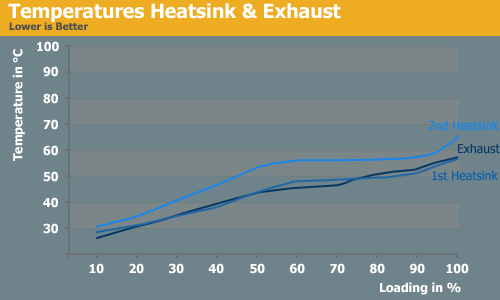
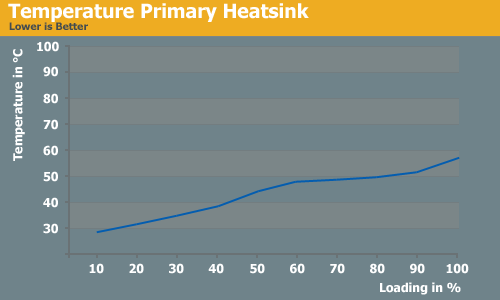
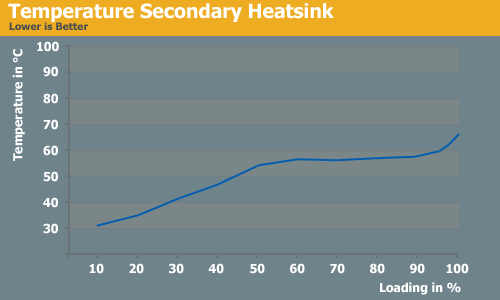
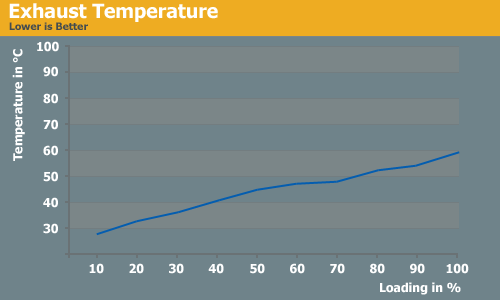
Under higher ambient temperature the heatsinks show similarities to room temperature. They get progressively warmer but the results are almost parallel to each other. The exhausted temperature is generally close to that of the primary heatsink. In comparison with the OP650 the secondary heatsink of the Silencer is much bigger in size. With the bigger size it has an increased capacity and better ability to transfer the heat into the air. The heatsink becomes cooler and can therefore cool components attached to it better.
We feel it is important to show what each power supply is truly capable of providing. The easiest way to separate the cream of the crop from inferior quality is to let the power supplies run in a very hot environment. Cheap components give up quickly and under stress conditions we can force lesser power supplies to fail. Good components will withstand the tremendous heat and keep on running. With increasing heat we will see the voltage of each rail dropping. This is a normal response from the components since they cannot deliver the same performance with increasing temperatures.

To heat up a box to 50°C you don't necessarily need a thermal chamber. For our tests we are using a natural circumstance. Our acoustic testing box is well isolated and will heat up with the running power supply inside. While this will not give us accuracy to a tenth of a degree, we can get a very good result for our use. To help the chamber heat up, we installed high wattage light-bulbs. If the temperature gets too high we cool it down with fresh air from outside. In this way we keep the same temperature for the different loads on each unit.




Under higher ambient temperature the heatsinks show similarities to room temperature. They get progressively warmer but the results are almost parallel to each other. The exhausted temperature is generally close to that of the primary heatsink. In comparison with the OP650 the secondary heatsink of the Silencer is much bigger in size. With the bigger size it has an increased capacity and better ability to transfer the heat into the air. The heatsink becomes cooler and can therefore cool components attached to it better.










31 Comments
View All Comments
rick5127 - Friday, February 12, 2010 - link
Thanks for the nice review.I am an enthusiast as I always push the envelope. A few years back I was running an ASUS PC-DL (dual socket 604 system) and started having flaky problems. After much testing we finally found it was a PSU problem. As I was running several of these machine 24/7 at 100% load (Folding at home project) I started eating power supplies. After much research we, several of us worked together on this, finally settled on a minimum spec of 30a for the 12v rail. This was about the time the dual rails started coming out. Well after burning up several of these I finally changed to PC-Power and cooling supplies and haven't had a problem in 10 years or so.
I get a kick out of some that say this 750 supply is too much. Well one of my systems that is running here has dual socket 775 quad cores with dual Geforce 9800 GTX+'s in it. Needless to say the 750 is close to maxed out.
In any case PC-Power and Cooling builds some of the best PSU's in the world and I wouldn't trust my systems to anything else.
I noticed the price here was listed at $199 I think... well NewEgg has a recertified 750 for $89 at the moment. FYI
Martimus - Thursday, July 19, 2007 - link
What is the difference between this PSU and the copper 750 Quad Silencer? Other than the fact his one is $30 more, the specs look the same between the two. Can you tell me what differences they have?meeshu - Thursday, July 19, 2007 - link
Once again no ripple results!Vidmar - Wednesday, July 18, 2007 - link
While I think the Efficiency charts in load percentage are nice, if you included Efficiency charts in watts it would be more informative from a buying perspective.The reason? I know the sum of system load is 375watts normally. The way it is now, if power supply XYZ has a max load of 650watts, I have to calculate where my ~375watts falls into that load chart (~57% load). But if the next power supply has 1000 watts max, then I have to yet again calculate what load percentage that may be for *that* power supply. If the Efficiency charts were in watts, instead of load, no calculations would be necessary. If I could look at your charts and see that XYZ power supply provided those watts the most efficiently, that would be the power supply I would get.
Maybe you could just provide a second X axis on the chart that included the watts.
Thanks!
bob4432 - Wednesday, July 18, 2007 - link
why is it rated @ 60A output on the 12V rail yet only delivered ~50A? so is 60A peak and not a ems amount? you got ~600W on the 12V, not ~720W like the math dictates.i know it is 10A (120W, quite a bit of difference imho) but does that mean that other psus that are rated @ 30A on the 12V line only put out 20A? or a 20A that only puts out 15A?
seems a bit misleading if they are mixing peak and ems amounts....
Martimus - Friday, July 20, 2007 - link
It is a DC output. There is no "EMS".bob4432 - Friday, July 20, 2007 - link
maybe i am thinking rms....hahabob4432 - Friday, July 20, 2007 - link
ok, so why is it still 10A lower than what it is listed as?Belldandy - Wednesday, July 18, 2007 - link
What was the ambient temperature when the efficiency tests were performed? I'm assuming the efficiency will go up when the ambient temperature is lower as it leads to lower temperature of the components.Also is the unit unable to hit 750 Watts? It states that the peak wattage is 825, and there's plenty of room for more current to be drawn from the 12V lines if it can indeed provide 60A current. Can it actually provide 825W of inrush current to power up large disk arrays?
Given the premium nature of this power supply, I wouldn't be surprised if it found it's way into video editing workstations with 2 Quad core cpus and a disk array of say 24 SATA drives.
Christoph Katzer - Wednesday, July 18, 2007 - link
The graphs show the efficiency at higher temps (25-50). You can see the exact temp on page 14.I will add the inrush and peak wattage test in the methodology.